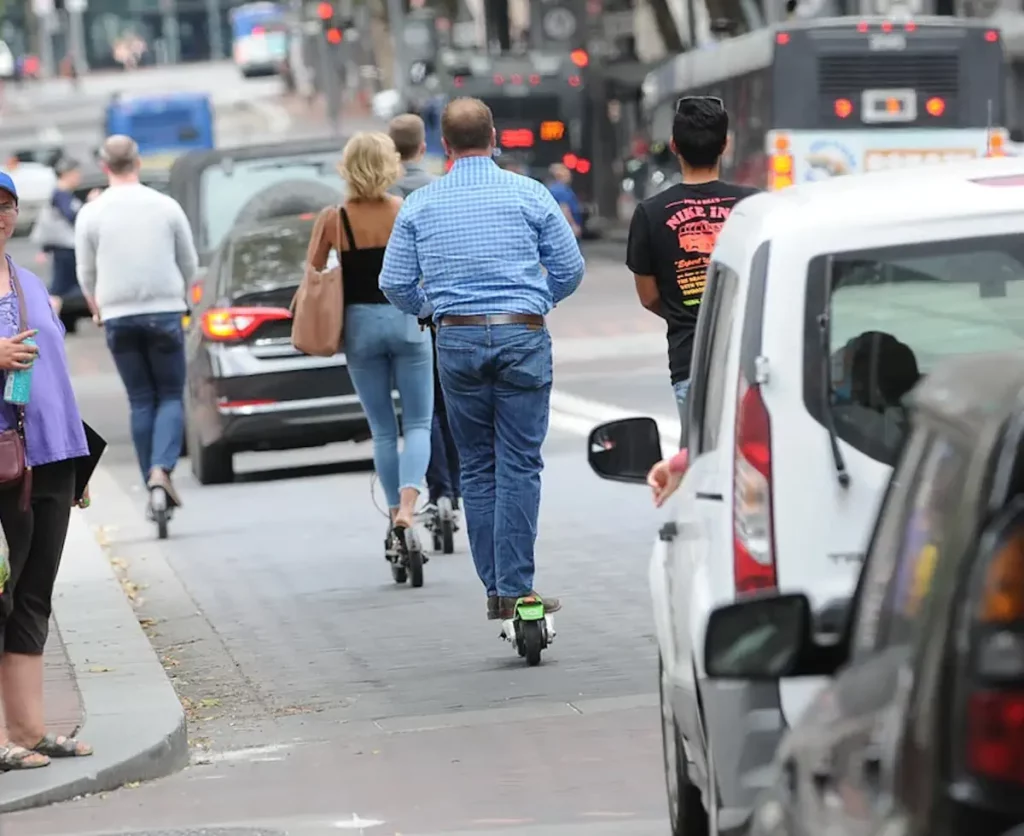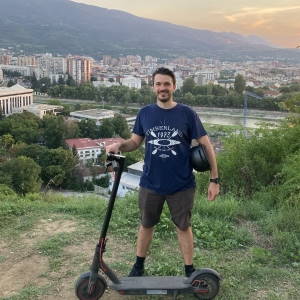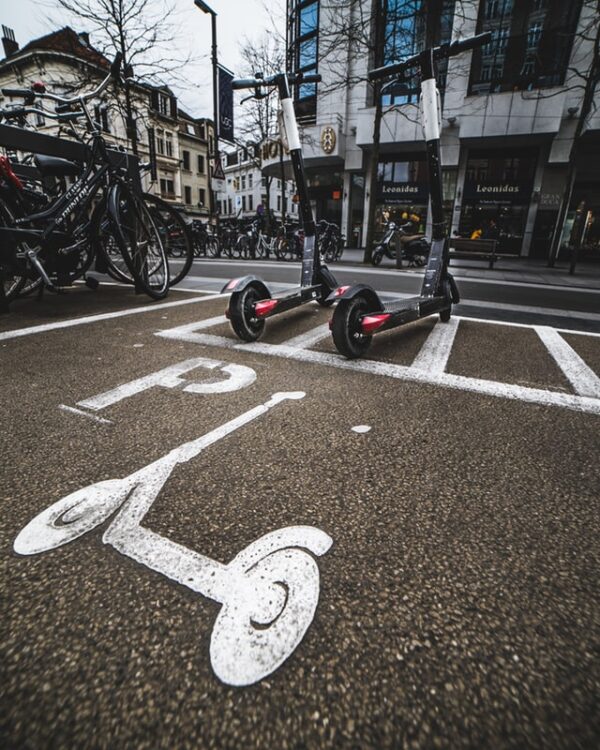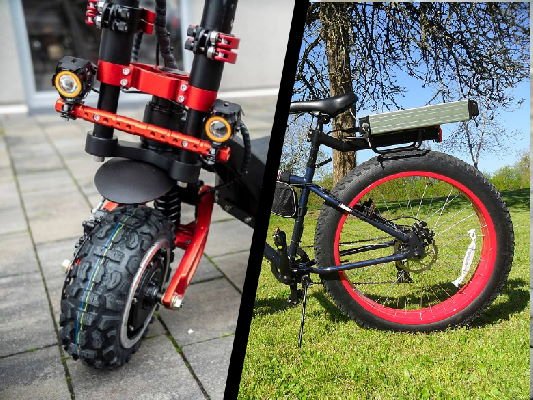This guide will offer the most surprising electric scooter statistics and data points about the electric scooter industry.

Electric scooter statistics
The global electric scooter market is expanding rapidly. According to Statista, the US and European markets are expected to reach $12 billion, with China at $6 billion and the global market reaching $32 billion by 2029. The Razor brand sold over 13 million electric scooters between 2003 and 2019. As of August 2020, the US has approximately 145 scooter-sharing systems.
Electric scooter trip distance and duration

Every day, some e-scooter statistics are done to find out some facts, common use, and better development
After a scooter-sharing pilot program in Chicago, the city of Chicago released the data they’ve collected from all the trips during the program. We can notice some very interesting data points from the 710.839 total rides.
The average electric scooter trip is 7.45 mi / 12 km long (precisely 11.977 meters) and takes 12 minutes and 2 seconds.
Please note that the data has some obvious flaws, such as extremely long trip distances (e.g., 134,000 mi / 215,653 km) and unrealistically long ride times (30 hours). These errors indicate issues with the dataset.
However, the overall data is reliable.
The averages do not align with each other, as it is implausible for most scooter riders to cover 7.45 mi / 12 km in just 12 minutes.
This would require an average speed of 37 mph / 60 km/h, which is practically impossible for novice riders using shared electric scooters. Examining the averages independently may provide better insights.
After cleaning the data (excluding trips under 100 meters or less than a minute), the averages still indicate an unlikely speed of 40 mph / 64 km/h.
The average trip duration is 13 minutes and 37 seconds, covering a distance of 9.07 mi / 14.6 km (14,653 meters).
In a scooter-sharing pilot program in Calgary, Canada, it was found that users have made 1.7 million trips on electric vehicles (90% on scooters), and the total distance traveled has been “85 times to the moon and back”.
It seems like scooters are getting more popular in Canada as time goes by.
Research on scooter use in urban environments finds that electric scooters are mostly used on roadways (33%), sidewalks (18%), and bike lanes (11%).
Electric scooter trends

Public opinion on electric scooters has evolved over time, moving from initial skepticism to growing acceptance.
The history of electric scooters has seen its share of ups and downs, but their recent impact suggests they are here to stay.
Individuals typically follow a path from initial astonishment, through criticism and skepticism, to curiosity, and ultimately acceptance, often after their first experience with electric scooters.
This pattern also reflects the changing public perception of scooters.
Several studies and surveys illustrate that the best.
A study in Washington DC, done by scooter rental company Bird, finds that 50% of their users use scooters primarily to get to and from work, and 29% of riders use Bird to connect to DC Metro and the bus.
Additionally, 23% of Bird rides replaced a ride-hail or taxi trip.
A Nacto study finds that in 2018 in the US alone, there have been 84 million scooter rides, and that’s only accounting for shared scooter rides.
Another study by Bird demonstrates the rising popularity of electric scooters, where they’ve found that in 2019, the number of electric scooter rides has risen to 136 million!
A survey in Hoboken, New Jersey, found that 74.5% of respondents were in favor of electric scooter-sharing programs to continue operating in the area, with 67% of the respondents having used electric scooters.
A 2020 survey done by Arizona State University and Ryerson University has found that:
- electric scooters are being used for transport primarily instead of leisure
- they have begun to replace walking and bicycles for all trip types
- the general public views them as convenient, fast, and cheap modes of transport
A survey of 1553 citizens of Edmonton, Canada, done in December 2020, has found that:
- 23% of respondents have tried using electric scooters, but more than half believe them to be useful and would probably try using one very soon
- 69% of respondents believe that scooters are a great mode of transportation
- 58% of respondents agree that electric scooters help connect people to their city
- 54% find electric scooters are enjoyable
- the main reason why some people haven’t tried using electric scooters has been the perceived lack of safety
- blocking the travel path, not parked in upright positions and too many e-scooters parked in one location were the most common issues reported around e-scooter parking
- non-users believe in stronger enforcement of measures to ensure scooters are used and parked properly
Besides the US and Canada, scooters in Australia are getting big as well. A study in Brisbane, Australia reports the following:
- 44% of public transit users used Lime scooters to connect to public transport in the last month.
- 18.7% of the riders using Lime reported that they had used a scooter to replace a ride that they would otherwise have been made by car
- 29.2% of riders used a Lime scooter for commuting to work or school, and an additional 37.5% used it for traveling to dining or entertainment.
- Three out of four survey respondents expressed a likelihood to use shared dockless scooters for future transportation needs, answering “likely” or “very likely”
Another study done by Ryerson University on 1640 adults finds that:
- one out of five would consider an electric scooter for their transport needs, were they available in their area
- most would substitute their walking and transit journeys with an electric scooter, but 37% would retain their current modes of transportation for all trips
A study from Christchurch, New Zealand finds the following:
- 71% of respondents have tried an electric scooter, and 75% of them had used a scooter more than once
- First-time users were curious, while continued users found scooters practical
- most of the regular users use scooters for their work commutes, social engagements, and shopping
- Repetitive users replaced 28% of trips by various vehicles and created 7% of entirely new trips
A comprehensive survey about electric scooters was done by a shared mobility program in Calgary, Canada.
The survey interviewed 7,671 people, including many scooter users. The study reveals several intriguing findings, such as:
- around 70% of participants agree that electric scooters are a good option for transportation
- around 15% believe scooters can reduce car trips
- the number of people who have tried a shared electric scooter has almost doubled between 2019 and 2020
- almost 50% used scooters for errands and social gatherings
In 2021 private electric scooter ownership increased, while numerous shared scooter companies either suspended operations (156 companies) or closed permanently. The data is available at the Bureau of Transportation Statistics.
Increased electric scooter usage is primarily driven by improving quality.
In a study on electric scooter problems done by EScooterNerds, it’s clear that electric scooter defects are rare and becoming even rarer due to advancements in design and technology.
There’s only a 7% chance of a budget scooter experiencing a significant malfunction in the first year, and this number is decreasing.
Another study by EScooterNerds on electric scooter lifespan reveals that 95% of all scooters can now last a full year without issues.
Electric scooter demographics

One research study done in December 2019 found that the majority of electric scooter users were men at that time.
A research study in July 2020 found that women had a more favorable view of electric scooters than men (72% of women viewed scooters favorably, as opposed to 67% of men)
A study by Lime in Jun 2019 found that:
- 54% of Lime users report an annual household income of $50.000 or less
- 1 in 4 Lime users are 36 years old or older
- the average age of the riders is 31 years
The Calgary, Canada shared mobility program study shows that over 50% of riders were aged 25-44, and nearly equal numbers of men and women used them (about 55% men and 45% women).
Electric scooters and the environment

Electric scooters are environmentally friendly since they reduce car use and greenhouse gas emissions. Fewer cars on the road means less pollution and fewer traffic jams.
A survey of electric scooter users in Vienna, Austria, shows that they replace cars for common trips, reducing pollution and traffic.
A model developed by the Institute of Transportation Studies at the University of California estimates that electric scooters could replace 32% of carpools.
The model developed by the Institute of Transportation Studies at the University of California estimates that electric scooters could replace 7.2% of taxi trips
One study from Portland, Oregon, finds that 47% of scooter users have replaced a car trip with their scooter.
Electric scooter market
The global electric scooter market is rapidly expanding.
Research from Statista predicts the US and European markets to reach $12 billion, the Chinese market to hit $6 billion, and the global market to reach approximately $32 billion by 2029.
In the period between 2003 and 2019, the Razor brand sold more than 13 million electric scooters.
As of August 2020, there are around 145 scooter-sharing systems in the US alone, as this interactive map shows.
Electric scooter injuries
One survey of citizens in Bloomington, Indiana reports that out of 122 respondents, 11 have suffered a scooter-related injury.
There are some health issues with prolonged electric scooter use.
In general, electric scooters are very safe, especially when they are used properly and all of the scooter safety riding guidelines are respected.
In fact, electric scooters may even provide a few health benefits, which is not something that most people would expect.
Electric scooter accidents

Research from DW suggests that electric scooters are safer than previously thought and may even be safer than bicycles.
In Sweden in 2019, nearly 500 scooter accidents occurred, with a significant portion involving riding under the influence of alcohol.
A study from the Los Angeles emergency rooms, which looked at riders admitted for scooter injuries, found that only 4.4% of riders were wearing helmets.
A bigger study from the Portland Oregon Bureau of Transportation, which looked at more than 700.000 scooter trips, found that there were 176 injuries (0.02%).
A study of scooter use in the US found that injuries related to electric scooters have increased by 222%, and hospital admissions due to scooter injuries have increased by 365% for a total of 3.300.
Electric scooter costs
There are several scooter price categories, most owners choose between several budget models, typically budget commuters, and while their prices can range from $199 to $799, most commuter scooters will cost around $426 on average.
These budget electric scooters for commuting will pay themselves off in 4-6 months by reducing transportation expenses.
Resulting in savings of approximately $400 to $600 in countries with lower living costs.
In the US you can save from $800 to $1200 per year with driving an electric scooter instead of cars and other vehicles.
Additionally, other electric scooter costs are minimal, as charging an electric scooter costs almost nothing.
Charging a typical budget commuter scooter, like the Xiaomi M365, during off-peak hours costs about 2 cents in the US, 4 cents in Canada, around 11 pence in the UK and Ireland, and approximately 7 Euro-cents on average in the EU.
Still to many people electric scooters still seem expensive and while electric scooters are indeed an investment, the cost that goes into research and development is what keeps their prices relatively high for a lot of potential owners.







